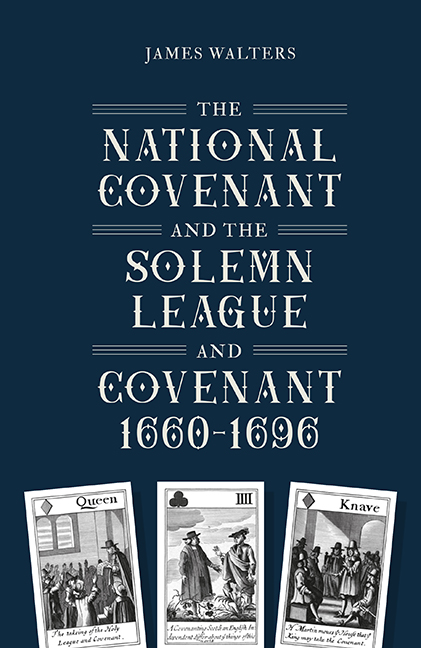Book contents
- Frontmatter
- Contentst
- List of Illustrations
- Acknowledgements
- Introduction
- 1 The 1638 National Covenant and the 1643 Solemn League and Covenant
- 2 1660: What Was to Be Restored?
- 3 The Act of Uniformity and the ‘Great Ejection’
- 4 Crisis and Toleration in the 1660s
- 5 Exclusion and Association in the Late Restoration Period
- 6 The Revolution of 1688 and the Association of 1696
- Conclusion
- Bibliography
- Index
- STUDIES IN EARLY MODERN CULTURAL, POLITICAL AND SOCIAL HISTORY
2 - 1660: What Was to Be Restored?
Published online by Cambridge University Press: 26 May 2022
- Frontmatter
- Contentst
- List of Illustrations
- Acknowledgements
- Introduction
- 1 The 1638 National Covenant and the 1643 Solemn League and Covenant
- 2 1660: What Was to Be Restored?
- 3 The Act of Uniformity and the ‘Great Ejection’
- 4 Crisis and Toleration in the 1660s
- 5 Exclusion and Association in the Late Restoration Period
- 6 The Revolution of 1688 and the Association of 1696
- Conclusion
- Bibliography
- Index
- STUDIES IN EARLY MODERN CULTURAL, POLITICAL AND SOCIAL HISTORY
Summary
The Restoration of Charles II in 1660 did not result in either any official place for the Solemn League and Covenant, or a presbyterian church settlement of the sort that had been the hope of the Covenant's supporters. On the contrary, the events of 1660–62 are, generally speaking, regarded as a triumph of episcopacy, and a defeat for Covenanting and presbyterianism. However, this is a view arrived at with the benefit of hindsight, and not necessarily one that contemporaries anticipated. Many Covenanters and presbyterians supported the idea of restoring the monarchy, and viewed the Restoration, initially, as a victory. For example, the Covenanter who in 1661 described the Restoration of Charles II as a divine act of ‘exemplary vengeance’ against those who broke the Covenant by killing Charles I clearly viewed the Restoration positively and as compatible with the Covenants. Presbyterians in England had supported the idea of restoring the monarchy in early 1660, and George Monck, whose march on London with an army from Scotland was instrumental in securing the Restoration, was supportive of the idea of instituting some form of presbyterianism. Samuel Pepys, writing in March of 1660, wrote of ‘the Covenant [being] printed and hung in churches again’, and associated this with ‘Great hopes of the King's coming again’.
Indeed, the king himself gave the impression that at least some form of compromise would be undertaken when he wrote in 1660 of reaching a settlement whereby the jurisdiction of bishops could be decided with input and consent from presbyters. Until ministers sympathetic to puritanism, presbyterianism, or the Solemn League and Covenant were ejected from the church on ‘Black St Bartholomew's Day’, many people thought that the post-Restoration church settlement would include presbyterians, or be in some way compatible with the Covenant. Indeed, Jeffrey Collins has argued that the Savoy Conference, which was called to settle the religious issues raised by the Restoration, and which ultimately led to the ejections of St Bartholomew's Day, was not initially intended to exclude presbyterians. Rather, the intention of the conference at first was to modify the prayer book in a way that might be more acceptable to presbyterians and find a way to accommodate them within the church. It has been argued that, in the case of Scotland, the Solemn League and Covenant had by 1660 become increasingly associated with sympathy for the Stuart cause.
- Type
- Chapter
- Information
- Publisher: Boydell & BrewerPrint publication year: 2022

